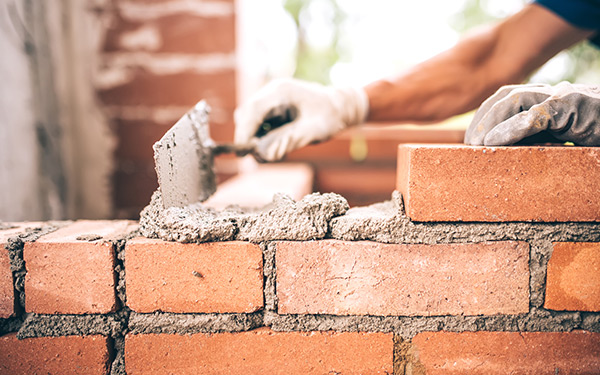Unlocking the Tricks of Sustainable Masonry Building And Construction Practices for Eco-Friendly Buildings
In the realm of contemporary construction, the quest of lasting practices has actually become paramount. Amongst the myriad techniques to environment-friendly building, sustainable masonry building and construction stands out as a time-tested and long lasting approach that holds a wealth of untapped capacity. From the selection of products to cutting-edge building methods, the secrets to accomplishing sustainability within stonework building are diverse and interesting. By checking out the benefits, products, strategies, and future trends of lasting masonry, a much deeper understanding of exactly how these practices can form the future of eco-friendly structures emerges.
Advantages of Sustainable Stonework Construction
Welcoming lasting stonework building practices not just lowers ecological effect but additionally uses long-lasting economic advantages to building contractors and neighborhoods. By utilizing products like recycled blocks, blocks, and stones, builders can significantly decrease the carbon impact of their jobs while promoting resource effectiveness. Additionally, lasting masonry construction strategies, such as proper insulation and thermal mass residential properties, can improve power efficiency within structures, causing reduced operational costs gradually.
Furthermore, the sturdiness and strength of masonry frameworks contribute to lasting financial advantages. Structures created utilizing lasting masonry methods often need much less maintenance and repair service, converting to cost financial savings for contractors and homeowner. The longevity of masonry products additionally guarantees that frameworks continue to be stable and safe, reducing the need for frequent improvements or replacements.
Eco-Friendly Masonry Materials
Making use of environmentally friendly stonework materials is a critical step towards boosting the sustainability of building and construction practices and reducing ecological influence while optimizing lasting economic advantages. Lasting stonework materials are sourced, produced, and utilized in a manner that decreases general ecological effect. Products such as recycled blocks, redeemed rock, and lasting cinder block are coming to be increasingly popular selections for eco-conscious contractors. Recycled bricks, for example, not only divert waste from landfills but also require less energy to produce compared to brand-new blocks. Redeemed rock supplies an one-of-a-kind visual charm while minimizing the requirement for new quarrying. Sustainable concrete blocks incorporate recycled accumulations and might include improved insulation buildings, adding to power performance in structures.
Furthermore, all-natural materials like adobe, rammed planet, and straw bales supply outstanding thermal mass residential properties, reducing the requirement for heating and cooling down energy. These materials are frequently locally offered, advertising regional economic climates and reducing transportation-related carbon discharges. By picking environment-friendly masonry products, building tasks can considerably lower their environmental impact and add to the creation of healthier, more sustainable constructed environments.
Energy-Efficient Masonry Methods
Energy effectiveness plays a crucial function in boosting the sustainability of stonework construction methods. By applying energy-efficient masonry methods, building contractors can considerably minimize the overall energy intake of a building, resulting in lower operational expenses and a smaller sized environmental footprint. One key energy-efficient masonry method is making use of thermal mass, which entails including thick materials like concrete or brick into the structure's framework to soak up and store heat. This helps regulate indoor temperature levels, reducing the requirement for mechanical heating and cooling systems.

Developments in Lasting Stonework
Current advancements in sustainable stonework practices have actually caused ingenious techniques that are improving the construction industry. One such development is the development heavy stone stamped concrete of self-healing concrete, which uses microorganisms embedded within the concrete to heal splits autonomously. This advancement not only lowers maintenance expenses yet likewise enhances the longevity of masonry structures, adding to their sustainability.
An additional notable development is using recycled accumulations in masonry building - masonry contractor. By integrating materials such as crushed ceramic waste or recycled glass right into concrete blends, contractors can lower the environmental influence of construction jobs while preserving architectural integrity. This method not only draws away waste from land fills however also preserves why not look here natural deposits, making it a crucial advancement in sustainable masonry construction
In addition, the assimilation of digital layout tools, such as Building Details Modeling (BIM), is reinventing the way stonework frameworks are planned and created. BIM enables more precise estimations, lowered material wastefulness, and enhanced power efficiency, inevitably leading to more lasting structure practices. These innovations collectively symbolize an encouraging future for lasting stonework construction in the age of environment-friendly buildings.
Future Trends in Masonry Sustainability
With the cutting-edge strides made in lasting masonry practices, the future patterns in stonework sustainability are positioned to additional reinvent the building and construction sector. One of the key patterns forming the future of stonework sustainability is the increased integration of technology. Developments such as Building Information Modeling (BIM) and digital reality simulations are being made use of to enhance masonry building and construction procedures, bring about minimized material waste and enhanced energy effectiveness in structures.
Moreover, the development of novel sustainable materials is readied to play a substantial function in improving the eco-friendliness of stonework building and construction. masonry contractor. Developments like self-healing concrete, recycled accumulations, and bio-based binders are acquiring grip for their ability to decrease astm c42 environmental effect while preserving structural honesty

Conclusion
To conclude, sustainable masonry construction techniques use countless benefits for environment-friendly structures. By making use of environmentally friendly materials and energy-efficient strategies, stonework can add to an extra lasting constructed environment. Developments in lasting masonry are continuously being created to further enhance the ecological efficiency of structures. Looking in the direction of the future, the pattern of masonry sustainability is expected to grow, resulting in more eco-friendly and energy-efficient construction practices in the years ahead.